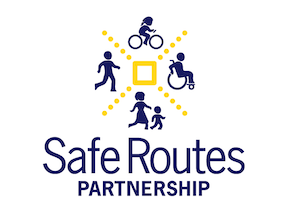Safe Routes to Libraries

Storywalk® image for 2024 library outreach in Washington, DC
Paving the Way for Safe Routes to Libraries
For 20 years, communities have been working to make it safer and easier for students to walk, bike, and roll to school. Safe Routes to School provides a tried, trusted, evidence-based framework for improving traffic safety and encouraging active travel to and from school, and in daily life. In recent years, new programs like Safe Routes to Parks and Safe Routes to Healthy Foods have applied the Safe Routes to School framework to other community destinations, proving the strength and effectiveness of this program.
Safe Routes to Libraries builds upon years of work from library staff, partners, and patrons to increase accessibility and promote physical activity. Initiatives like UNC Greensboro’s Let’s Move in Libraries take a public health approach to library programming, laying the groundwork for Safe Routes collaborations. Library staff are participating in transportation planning, organizing walking school bus programs, and securing infrastructure funding to support walking, biking, and rolling. Their success positions Safe Routes to Libraries to adopt a more formal framework in the coming years.
Our Journey to Safe Routes to Libraries
The Safe Routes Partnership has actively cultivated relationships with libraries, recognizing their role as community hubs. Here’s a look at our recent efforts:
- 2019 – Safe Routes to Parks grantee Central Arkansas Library System (CALS) focused their project on improving safety and access to the library. After a successful demonstration project, they installed temporary pedestrian and bike lanes in front of the library branch. The City of Little Rock applied for and received 1 million dollars in federal funding to install permanent infrastructure at the site.
- 2022 – Public library staff presented at the Safe Routes to School Virtual Summit. Their session “From Bikes to Books: Exploring Partnerships Between Safe Routes to School and Public Libraries” sparked a wave of interest from Safe Routes practitioners looking to engage librarians. This inspired us to build relationships with library partners and seek funding to support Safe Routes to Libraries.
- 2024 – The Safe Routes Partnership announced an exciting new project with Urban Libraries Council, funded by a National Leadership Grant from the Institute for Museum and Library Services (IMLS). This 18-month planning project will create a Safe Routes to Libraries framework to increase safety, accessibility, and physical activity around public libraries.
Why Safe Routes to Libraries?
Libraries are essential community destinations.
Public libraries exist to serve the community. From printing and copying to tax preparation assistance to nutrition and wellness classes, libraries do it all at no cost to patrons. During COVID, patrons visited the library to get vaccinated, drop off voting ballots, and pick up food. This reinforced libraries as essential community destinations that must remain safe, open, and accessible.
Libraries serve a broad user base.
Libraries play a pivotal role in developing a sense of social connection, safety, and independence for vulnerable populations like children and teens, older adults, and unhoused people. Libraries are one of the only free and open spaces to the public. Creating safe walking, rolling, and transit routes ensures everyone can enjoy the library’s benefits regardless of age, race/ethnicity, ability, or income.
Libraries are already doing Safe Routes work.
Libraries nationwide participate in safe routes activities, from providing space for transportation planning meetings to organizing walking school bus programs. Check out these national examples of Safe Routes to Libraries in action!
- BikeWalkKC recognized the Kansas City Public Library as its 2024 Partner Champion Organization for its support of transportation advocacy. The library hosted five screenings of The Street Project, during which community members shared their traffic safety priorities. The library also has a dedicated health and well-being specialist who focuses on public health programming, including blood pressure check machines and fitness classes.
- Baxter County Library in Mountain Home, Arkansas, secured nearly $500,000 in Transportation Alternatives Funding to enhance pedestrian and bicycle friendly access through a trail connectivity project. The project provides safe walking and rolling routes for students and patrons to access the library and strengthens the library’s role as a central hub for active transportation. The library foundation was pivotal in applying for Arkansas Department of Transportation funding and collaborating with local partners to create an active transportation network.
- Safe Routes to Libraries and Safe Routes to Healthy Foods converge at Baltimore’s Enoch Pratt Free Library. The Pratt Free Market is a free grocery store at the Southeast Anchor Library Branch. The location is accessible by transit and active travel modes. To address food insecurity, libraries are stepping up to provide food pantries, food distribution services, and mobile farmer’s markets, with safe routes being key to the success of these initiatives.
- Volusia County Public Library in Northeast Florida empowers low-income, working adults with reliable transportation through The Pedal Forward Project. Launched by social workers who recognized their clients need reliable transportation, the project works with community partners to donate bikes, bike locks, and helmet vouchers. The Pedal Forward project helps participates reach critical jobs, appointments, and essential services, including increased access to the library.
- Canton, New York’s Complete Streets Committee, used leftover funds from a Main Street Improvement grant to install bike racks and a bike shelter at the village library. The project was approved because the funds were used for a Complete Streets purpose. The new bike racks and shelter provide more bike parking on Main Street and increase access to Canton Public Library.
How Safe Routes Programs Can Partner with Libraries
- Host a Safe Routes event at the library. Not all Safe Routes to School activities have to take place on a school campus. Think about hosting your next bike rodeo or outreach event at the local library. Many libraries have meeting rooms and space for outdoor activities. The library can also be a gathering place for Walk and Roll to School Day, remote drop-off/pick-up, and walking school bus programs.
- Get to know library staff. Similar to school staff, library staff wear various hats. Contact the branch manager if you are connecting with your library for the first time. The library branch manager oversees staff and general operations. Some libraries have dedicated community engagement and outreach staff. Others have social work and public health staff interested in partnering with Safe Routes programs. Additional support staff can help with room reservations and setting up event spaces. Library staff are typically friendly and helpful. If you’re unsure of something, ask!
- Engage library staff early and often. Libraries are not always engaged in Safe Routes to School and transportation projects. Invite library staff to participate if you are creating an action plan, organizing a demonstration project, or coordinating a Safe Routes to School task force. Libraries are a trusted community resource and are equipped to engage the public. Their expertise and knowledge can expand your program's reach and bring new perspectives.
How Libraries Can Partner with Safe Routes Programs
- Learn about the history of the Safe Routes movement. These videos explain the history and purpose behind Safe Routes to School and Safe Routes to Parks.
- Explore Safe Routes in your community. Check with your local school district, transportation/public works department, or public health department to see if they have a Safe Routes to School program. You can also see if your community has a Safe Routes to School or active transportation plan. Here are a few to look for:
- Safe Routes to School Action Plan
- Bicycle Master Plan
- Pedestrian Master Plan
- Complete Streets Plan
- Vision Zero Action Plan
- Comprehensive Plan
- Connect with local agency staff and community organizations. Safe Routes programs rely on successful collaborations, and Safe Routes practitioners are everywhere. Local Safe Routes programs typically operate through a government agency, school district, or non-profit. Here are a few places you might find Safe Routes staff, including the Safe Routes to School Coordinator:
- City or County Transportation Department
- City or County Public Works Department
- City or County Public Health Department
- City or County Planning Department
- School District
- Transportation Advocacy Organizations
Interested in partnering on a Safe Routes project and don’t know where to start?
First, see if your community has a Safe Routes to School Coordinator. For infrastructure projects, reach out to your transportation department or public works department. For physical activity programs, connect with your public health department.
If you are still unsure, email info@saferoutespartnership.org.
Our Safe Routes to Libraries journey is just getting started! Stay tuned for more project updates, resources, success stories, and more.
Safe Routes to Libraries Resources
- Webinar: How Public Libraries are Advancing Safe Routes Advocacy, Funding, and Programming
- There’s a New Partner in Town! How Public Libraries are Advancing Safe Routes Advocacy, Funding, and Programming
- From Bikes to Books: Exploring Partnerships Between Safe Routes to School and Public Libraries
- Guest Blog: 5 Reasons Why Your Public Librarian Is the Key to Your Next Safe Routes to School Partnership

